
|
"Outstanding keeper instruction. This is a must for goalkeepers and coaches." — Ottawa Internationals S.C. web site, Ottawa, Canada |
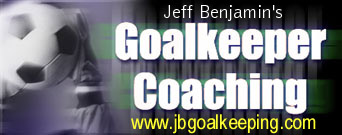
|

|
|
|
Top |
Next: Diving
|
The one thing I could always do, that I knew I could do, was catch the ball. I had that confidence in my hands.
-- Frank Borghi, goalkeeper for the U.S. team that beat England in the 1950 World Cup
The only advantage a goalkeeper has over any other player on the soccer field is that they can use their hands. In this way, a goalkeeper can control the ball in a way no other player can, but to gain this control, they must catch the ball.
Catching technique is second only to footwork in making a safe, solid keeper. "Soft" goals that just slip into the net and rebound goals are tough for the keeper and the entire team to deal with. Proper training and practice can prevent these.
The Two Principles of Catching
The first thing to remember about catching a soccer ball is
![]() always get the hands to
the ball first!. The occasional kick save may be necessary, but
a goalkeeper's hands are their advantage and they should always
try to exercise that advantage whenever possible. The "hands to the
ball first" axiom applies to every single technique in goalkeeping.
always get the hands to
the ball first!. The occasional kick save may be necessary, but
a goalkeeper's hands are their advantage and they should always
try to exercise that advantage whenever possible. The "hands to the
ball first" axiom applies to every single technique in goalkeeping.
The second thing is a keeper must have "soft hands". This means they
must use their arms, back and legs to cushion the ball, absorbing its
energy and allowing them to hang on to it. When reaching for a ball,
the arms should be extended (but don't lock the elbows!), then the elbows
bend as the catch is made, allowing the
arms to absorb the speed of the ball. The keeper can also bend back
a bit at the waist to help cushion the ball.
![]() A quiet catch is a good,
soft catch. If the ball loudly slaps the hands, the keeper is not
giving enough with the ball.
A quiet catch is a good,
soft catch. If the ball loudly slaps the hands, the keeper is not
giving enough with the ball.
![]() Don't allow the keeper to take
steps backwards to cushion the catch - remember, the keeper should
always move forwards towards the ball.
Don't allow the keeper to take
steps backwards to cushion the catch - remember, the keeper should
always move forwards towards the ball.
There are several basic types of catches used by soccer goalkeepers.
- The "W" or Contour Catch
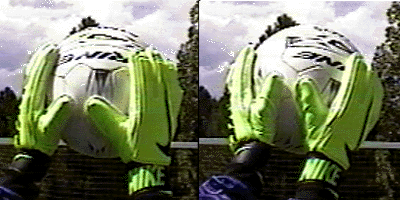
Fig. 1a (L), 1b (R): The "W" or contour catch
The "W" or contour catch is used for any ball from about waist height up. The hands cradle the contour of the ball, with the thumbs and index fingers forming a "W" behind the ball (Fig. 1a). It's critical that the hands,
especially the thumbs, be behind the ball -
It's critical that the hands,
especially the thumbs, be behind the ball -
 if a keeper tends to
catch the sides of the ball, without the strong thumbs behind, they will
let balls get through their grip and let in easy goals.
if a keeper tends to
catch the sides of the ball, without the strong thumbs behind, they will
let balls get through their grip and let in easy goals.
The hand position can be varied somewhat. For younger keepers or those with small hands, bring the wrists closer together, thumbs almost parallel, to get the most stopping power behind the ball (Fig. 1b). More experienced keeper with more hand strength should rotate the wrists outward, getting more of the contour of the ball and thus better control.
For balls high in the air, the hand position is the same. However, the goalkeeper must also take additional steps to ensure they can catch the ball cleanly:
- Jump to catch the ball at the
 highest point possible.
highest point possible.
 Keepers must not wait on a
high ball in the air and make a basket catch at the waist! They must
get to the ball above their heads. If the ball is not caught high,
attackers can rush in and head the ball away before it gets to the
keeper's hands. Watch carefully for this and
insist they use proper technique.
Keepers must not wait on a
high ball in the air and make a basket catch at the waist! They must
get to the ball above their heads. If the ball is not caught high,
attackers can rush in and head the ball away before it gets to the
keeper's hands. Watch carefully for this and
insist they use proper technique.
- Raise one knee, the one nearest any opposing pressure, as they jump.
This provides extra boost for the jump,
and also can provide some protection against onrushing forwards.
 However, a goalkeeper
should never raise their knee with intent to injure or "send a
message" to another
player. The knee is primarily used to generate additional height on
the jump, secondarily as a fender against collisions. It should be kept close in to the keeper's body.
However, a goalkeeper
should never raise their knee with intent to injure or "send a
message" to another
player. The knee is primarily used to generate additional height on
the jump, secondarily as a fender against collisions. It should be kept close in to the keeper's body.
If the keeper gets their hands to a high overhead ball, but the ball
 rolls off their hands and down,
they may need to
rolls off their hands and down,
they may need to
 cock their wrist back
more to get the hands in better catching position.
cock their wrist back
more to get the hands in better catching position.
- Jump to catch the ball at the
-
The Inverted Contour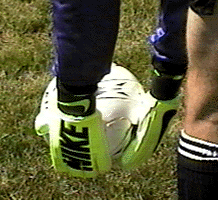
Fig. 2: Inverted contour catch
For balls below the waist, the inverted contour or basket catch is used. The hands are again behind the ball, this time downwards with the pinkies together (Fig. 2). Here again it is critical for the hands to be behind the ball.
it is critical for the hands to be behind the ball.
For very hard, low shots, the goalkeeper needs to ensure their momentum is forward and their weight is over the ball. Older, more advanced goalkeepers should use the front smother technique for these shots (see the Advanced Diving page).
- Ground or Rolling Ball Pickup
There are several techniques for picking up a rolling ball. For all of them, the keeper must
get their hands all the way down, fingertips brushing the ground to
ensure a clean catch.
must
get their hands all the way down, fingertips brushing the ground to
ensure a clean catch.
The straight-leg pickup seems to be falling out of favor lately, and most goalkeepers use the knee-bent pickup and its moving variation. in fact, since basic footwork principles tell us we should move forwards to the ball, the moving pickup is probably used the most of any of these techniques.
-
Straight-leg pickup (Fig. 3) - the keeper bends from the waist, slightly bent
at the knees, with feet behind the ball. Catch with the hands, then
bring up to the chest. Use this save when there is no pressure.
 Watch out for young or not very
flexible keepers who bend from the waist but cannot get their hands
all the way to the ground. This is a recipe for missed balls. These
keepers should probably use the following bent-knee pickup instead.
Watch out for young or not very
flexible keepers who bend from the waist but cannot get their hands
all the way to the ground. This is a recipe for missed balls. These
keepers should probably use the following bent-knee pickup instead.
 Also, a keeper should not use this
type of save when under pressure from opposing forwards. It does not
allow enough ability to move out of the way if necessary, and puts the
head low and in a vulnerable position as well. Use a moving-ball pickup,
below, to run through the ball or out of harm's way, or make a sliding
save as for a breakaway.
Also, a keeper should not use this
type of save when under pressure from opposing forwards. It does not
allow enough ability to move out of the way if necessary, and puts the
head low and in a vulnerable position as well. Use a moving-ball pickup,
below, to run through the ball or out of harm's way, or make a sliding
save as for a breakaway.
-
Knee-bent pickup (Fig. 4) - keeper staggers their feet slightly, one just behind
the other. Keeper bends at knees and waist, one foot beside the ball
and the other behind the
ball, catch with the hands and then bring up to the chest.
 Although the feet are staggered,
they should be behind the ball and close enough together that a ball
cannot slip between them.
Although the feet are staggered,
they should be behind the ball and close enough together that a ball
cannot slip between them.
-

 Moving pickup - similar to a knee-bent pickup, but used when the keeper
is on the move towards the rolling ball. The foot on the goal side
of the ball is placed beside the ball, the other foot behind the ball.
Keeper is low as they approach the ball, scoop with hands behind the
ball
Moving pickup - similar to a knee-bent pickup, but used when the keeper
is on the move towards the rolling ball. The foot on the goal side
of the ball is placed beside the ball, the other foot behind the ball.
Keeper is low as they approach the ball, scoop with hands behind the
ball  and not on the sides of the
ball, and continue to move through the ball in one continuous motion.
and not on the sides of the
ball, and continue to move through the ball in one continuous motion.
-
Knee-down pickup (Fig. 5) - contrary to what many young goalkeepers
seem to be taught, this save is actually one of the least used because
it restricts mobility.
 This technique is only used in special situations,
on long, low, hard shots on uneven fields or wet grass. It gives the
keeper the largest "backstop" for low balls that may be difficult to
corral. Keeper bends one knee; the other goes down almost to the ground
and very close to the other heel.
This technique is only used in special situations,
on long, low, hard shots on uneven fields or wet grass. It gives the
keeper the largest "backstop" for low balls that may be difficult to
corral. Keeper bends one knee; the other goes down almost to the ground
and very close to the other heel.
 The down knee should not touch the ground and should not bear any weight,
so that the keeper can easily get up and move if need be. Also, the
gap between heel and knee should be less than a ball width, for obvious
reasons.
The down knee should not touch the ground and should not bear any weight,
so that the keeper can easily get up and move if need be. Also, the
gap between heel and knee should be less than a ball width, for obvious
reasons.
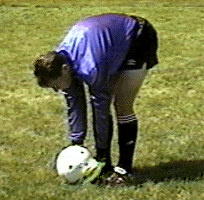
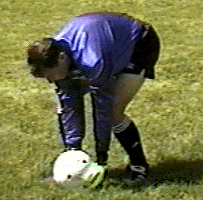
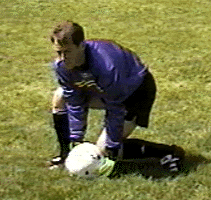
Fig. 3: Straight-Leg Pickup Fig. 4: Bent-Knee Pickup Fig. 5: Knee down pickup For any low balls, the legs must be kept more or less together and
 behind the ball.
behind the ball.
 Opening the legs invites the
"ole" goal right through the wickets - quite embarrassing for the keeper!
Opening the legs invites the
"ole" goal right through the wickets - quite embarrassing for the keeper!
-
Straight-leg pickup (Fig. 3) - the keeper bends from the waist, slightly bent
at the knees, with feet behind the ball. Catch with the hands, then
bring up to the chest. Use this save when there is no pressure.
Protecting the ball after a catch
The proper position for protecting a ball after a catch is made is
shown in Fig. 6. Both forearms vertical, with hands curled over the
top of the soccer ball. In this position it is almost impossible to dislodge
the ball. ![]() The forearms should
never be held horizontally like a running back receiving a handoff.
The forearms should
never be held horizontally like a running back receiving a handoff.
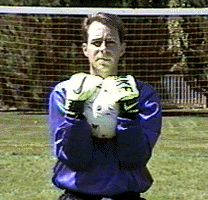 Fig. 6: Protecting the ball |
Your keeper should not attempt to protect the ball too soon after a
catch. Too often, ![]() keepers
attempt to bring the ball to the protected position before they have
made a clean catch, and end up bobbling the ball, or attempt to make
a "catch" in the protected position and end up having the ball ricochet
away from their chest or forearms. I cannot stress
enough that
keepers
attempt to bring the ball to the protected position before they have
made a clean catch, and end up bobbling the ball, or attempt to make
a "catch" in the protected position and end up having the ball ricochet
away from their chest or forearms. I cannot stress
enough that ![]() catch must
always be made with the hands first. In fact, if there is no pressure
on the goalkeeper, it may not be necessary to protect the ball at
all. If the catch is secure, the keeper should be able to simply hold
the ball in the catching position. Catch/protect should be two
distinct actions -
catch must
always be made with the hands first. In fact, if there is no pressure
on the goalkeeper, it may not be necessary to protect the ball at
all. If the catch is secure, the keeper should be able to simply hold
the ball in the catching position. Catch/protect should be two
distinct actions - ![]() in fact,
they should be two distinct sounds as the goalkeeper makes the
save - the first the sound of the ball hitting the hands, then the
sound of the ball being protected against the chest.
in fact,
they should be two distinct sounds as the goalkeeper makes the
save - the first the sound of the ball hitting the hands, then the
sound of the ball being protected against the chest.
![]() Also, do not allow the
goalkeeper to bat the ball in front of them and then catch it. They
should be able to "stick" the catch in good catching position right
away, using arms, back and legs to cushion the ball as mentioned above.
Also, do not allow the
goalkeeper to bat the ball in front of them and then catch it. They
should be able to "stick" the catch in good catching position right
away, using arms, back and legs to cushion the ball as mentioned above.
Quick Summary - Catching: |
Mistakes to Watch For: |
||||||||||||
|
|
|
|
|
Top |
Next: Diving
|